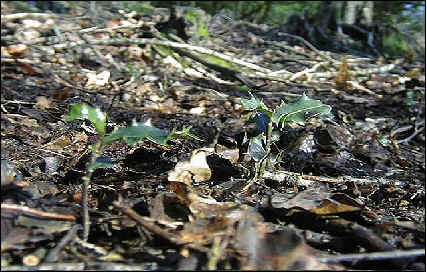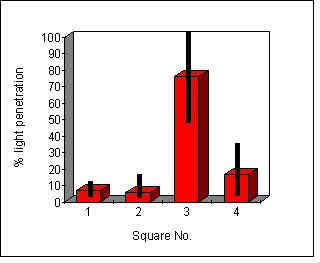 |
Woodland Restoration Project
| The removal of rhododendron from the area represented by square 3 has resulted in greatly increased light levels in this area (Fig.9). This factor has obviously allowed holly seeds not only to germinate, but also to survive. Their mean height was 5 cms (Fig.8, second value for square 3). Holly seedlings were not found anywhere else on the site. |
| The saplings must be surviving relics of
seedlings which germinated in this area before the rhododendron canopy closed over. Poor
soil conditions must have led to much slower growth of the rhododendron in this region. Presumably this
allowed the seedlings to survive, where in other areas, the rhododendron was already too
dominant, with light conditions under the canopy which were too dim for plant growth.
|
 Figure 9. Mean % of light penetration Figure 9. Mean % of light penetration The percentage of light penetrating through the rhododendron canopy is very low. In square 1, mean light penetration was 7% and in square 2, 6% (Fig. 9). ( On a dull day, in the densest regions of the rhododendron, a torch was necessary in order to be able to see to carry out the sampling.) Light levels vary under the rhododendron, depending on local densities of the leaf canopy. The measured range of light penetration is represented by the vertical black lines (Fig.9). The holly saplings in square 1 must be in an area with slightly higher local light levels in order for them to survive in such low light conditions. Holly is an understory tree and so is adapted to lower light levels. No other tree seedlings were found in the area. |